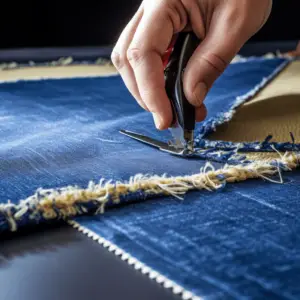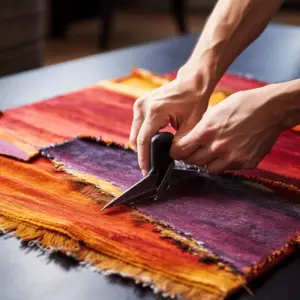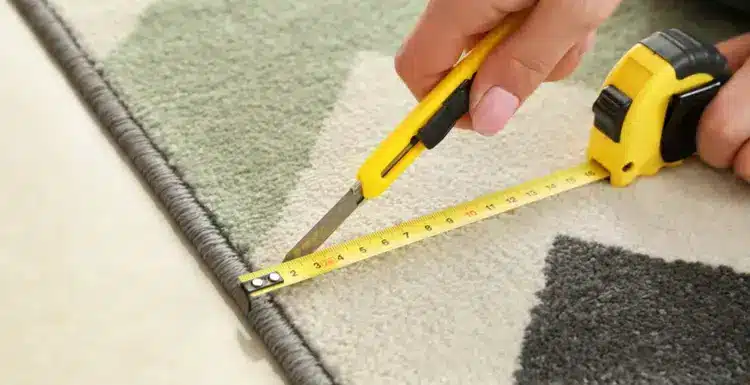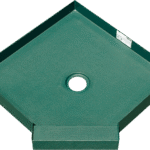Rug Cutting Techniques, Nobody wants to get home and discover their lovely rug has frayed edges. It’s not only unattractive, but it could also indicate that your carpet requires major or little repairs.
Fraying most commonly occurs when cutting a rug. You can easily destroy an otherwise nice rug by leaving frayed edges if you’re not careful.
While the issue may not appear serious initially, it might eventually cause the entire rug to fall apart. So, how can you cut a rug without it fraying?
A sharp cutter and adequate force are the keys to cutting a rug without fraying it. A hard substance, like a plank, can also be used as a guide to ensure a good cut. Once you’ve finished cutting, go over all of the edges to make sure there are no frays.
Table of Contents
Tips on How to Cut a Rug Without it Fraying

Utilize a Sharp Cutter
Rug Cutting Techniques all about having the right tools and understanding how to use them properly if you want to cut a rug without fraying it. A sharp cutter will cut straight through the rug without dragging any threads behind it, making all the difference.
On the other hand, a dull cutter will constantly tug on the edges as you run it along. It will also not cut all threads evenly, leaving parts of them hanging. That’s a surefire method to get many frays.
Rug Cutting Techniques currently own a cutter that you enjoy using, consider sharpening it. This will save you money if you do not want to purchase a new cutter.
Use Force When Cutting
Another crucial point to remember is to use much force when cutting. The use of a sharp edge is simply one component of the puzzle. You must also cut with confidence and provide enough pressure to ensure that the cutter glides effortlessly through the material.
You can quickly destroy the entire cut if you hesitate for even a second. Resuming a cut from the halfway point while preserving the original direction might be tricky. That’s why you should double-check your measurements and only cut once you’re confident you’ve got it right.
Before you begin, make sure your rug is on a safe surface. Even if your floor is tough, you don’t want to risk ruining it by using a sharp cutter.
Make Use of a Guide
A wooden board or something similar can be helpful. It might assist you in making sure you’re cutting in the appropriate direction without going too far off track. It can also enable you to use more force during your cuts without worrying about straying off course.
Make sure anything you choose as a guide is strong enough to keep the cutter from going beside it. If the boards are made of hardwood or similar material, they are appropriate. Otherwise, you might want to use a metal or other sturdy item as a guide.
Cut Off Any Leftover Threads
Rug Cutting Techniques threads are hanging out from the edges, gently cut them one by one as you walk around the rug. When compared to the earlier cuts, this necessitates a more cautious technique.
Before cutting each thread, pull on it to ensure it isn’t longer than it appears. As you make the incision, keep the thread stretched. Repeat for each thread that protrudes from either of the edges.
This can take some time, but it’s necessary to ensure that your rug looks beautiful.
Also, it makes no difference whether you bind the edges or not. Before continuing to the following step, you should remove any remaining threads.
Bind or Serge the Edges

You might consider binding or serging your rug once you’ve cut it to size. This will increase the rug’s durability while also improving its appearance.
Some people dislike serging because they believe it detracts from the aesthetic appeal of most rugs. That isn’t always the case. It is primarily dependent on how skillfully the serging is done.
If you wish to bind your rug, select high-quality materials. High-quality carpet glue can significantly affect how well the end product looks and lasts.
If you’re unsure about your abilities, it might be worth taking the rug to a professional for the last step.
Frequently Asked Questions
How Much Does Carpet Edge Binding Cost?
The cost of having your carpet bound by a professional varies based on where you reside. Most professional carpenters bill by the linear foot of the area that needs to be bound.
It might cost anywhere from $1 and $3.50 per foot. A 10×10 room, for example, would cost $40-$140.
Alternatively, you can get a carpet binding kit for approximately $20 or a heat gun for around $25 if you want to do the binding yourself. Additional binding materials may be required, bringing your total cost to roughly $40 to $60.
Is It Possible To Bind A Carpet By Yourself?
Yes, you can bind your carpet without hiring a professional carpenter, especially if the area is small. The length of the carpet area that needs binding is the most important thing to consider when selecting whether or not to do it yourself. This will help you estimate how much it will cost to outsource the project against the time, cost, and effort required to accomplish it yourself.
Is It Possible To Cut A Rug Down To Size?
With the help of a carpet cutter, you may cut a rug down to size. This procedure should be cautiously approached because it cannot be reversed once the cut is performed.
How Do You Seal the Edges of a Carpet Remnant?
You should use hot glue and run it around the edge of a carpet remnant to seal the edges. This will help attach it to the inner edge, giving it a more compact appearance.
Final Words
Now that you know how to trim a rug without fraying the edges, you should practice the skills on a less expensive rug before moving on to the one you want to cut.
There are a few secrets to the cutting process that take some practice to master. And you don’t want to do it on rugs you’ll later regret losing.


